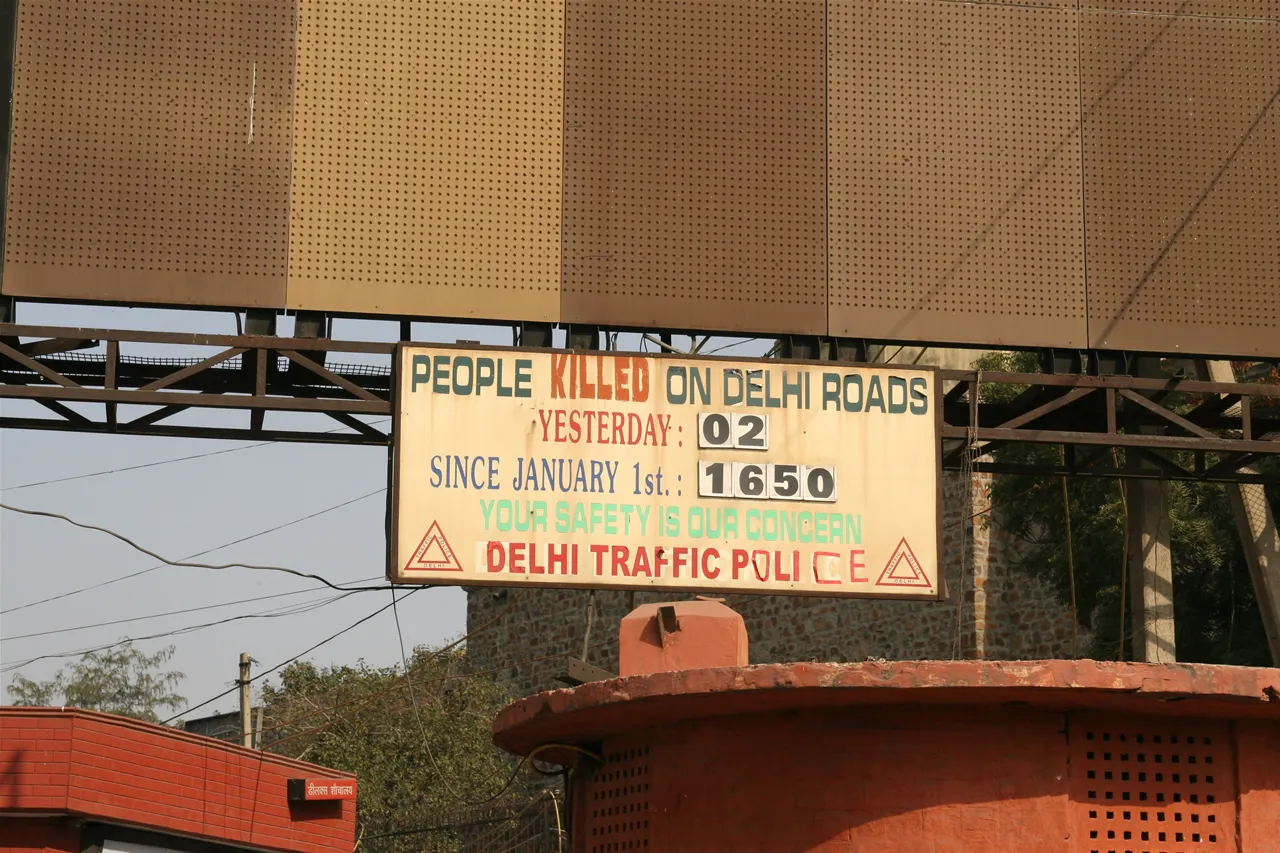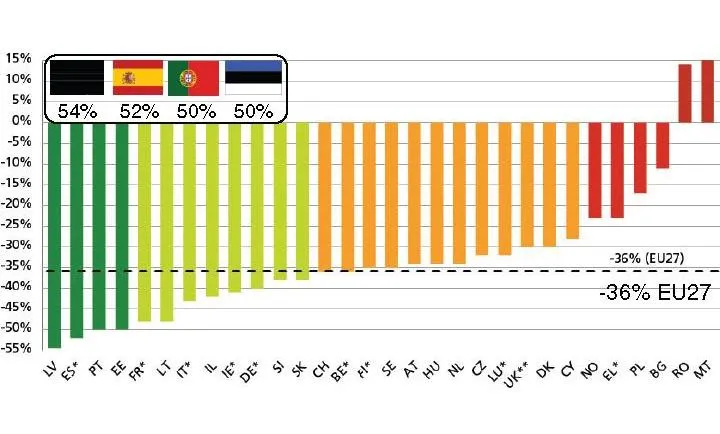Sibylle Rupprecht, IRF-GPC Director General, looks towards sound mobility management at the 3rd Regional Conference of the International Road Federation 3rd-4th October 2008 in New Delhi, India More than 1.2 million deaths and 23 million injuries are caused by road accidents worldwide every year. Of these, India accounts for 10% of fatal accidents. These alarming figures were disclosed by the speakers at the 3rd Regional IRF Conference on 'Mobility and Safety in Road Transport' to some 250 engineers and exp
July 18, 2012
Read time: 6 mins

Sibylle Rupprecht, IRF-GPC Director General, looks towards sound mobility management at the 3rd Regional Conference of the 713 International Road Federation 3rd-4th October 2008 in New Delhi, India
More than 1.2 million deaths and 23 million injuries are caused by road accidents worldwide every year. Of these, India accounts for 10% of fatal accidents. These alarming figures were disclosed by the speakers at the 3rd Regional IRF Conference on 'Mobility and Safety in Road Transport' to some 250 engineers and experts who took part in this event. KH Muniyappa, minister of state for Shipping, Road Transport and Highways, inaugurated this important conference, which was organised by the Geneva-based International Road Federation.
In the context of massive road development activities in the region and India in particular, road transport has become more and more attractive over the years. The high demand for mobility brought a substantial growth in motor vehicle ownership, including motorcycles, coupled with poor road user behaviour. This has led to a serious concern about the road safety situation.
The3263 World Health Organisation (WHO) estimates that worldwide road traffic injuries will move up from 9th position of leading causes of death in 2004 to 5th position by 2030. This means that the current figure of 1.2 million victims is set to double by 2030. Road crashes are the leading cause of death for young people aged 10-24. According to the WHO projections, road crashes will be the leading cause of disability and premature death for children aged 5 and over in developing countries by 2015.
Road crashes cost developing countries up to $100 billion each year, a figure equivalent to all official overseas aid.
About two-thirds of road accidents and one-third of road fatalities occur in urban areas, with pedestrians and cyclists being the most vulnerable road users. To save lives, there is a requirement for safer infrastructure, safer behaviour, safer vehicles and better enforcement of traffic rules.
Efficient urban mobility which is both safer and more environmentally friendly is essential to guarantee a higher quality of life. Cities should be places where people can live, work and spend their leisure time, being at the same time affordable.
It is against this background, that the 3rd Regional IRF Conference looked into the following four broad themes: Urban Mobility and Safety; Road Developments and Safety Implications; Management of Mobility and Road Safety; Institutional and Legislative Capacity for Road Safety.
The Conference deliberations and the panel discussion showed a high degree of passion for ensuring mobility in developing countries without compromising on high standards of safety. In the valedictory session, 18 important proposals were elaborated, recognising that actions must include the three E's (Engineering, Education, and Enforcement).
KK Kapila, conference chair and vice chairman of IRF summarised the key recommendations: It is recommended that all agencies must work collectively to reduce road fatalities substantially in the next three years with a built-in review mechanism. Besides, a mission-oriented concerted effort is required to reach safety targets by reducing the risks from all perspectives. This effort should include major advertising and educational campaigns for the public at large. The states are encouraged to subscribe to this. The IRF will consider introducing a national award to recognise the state with the highest reduction of fatalities. The traffic police officers demonstrating a high level commitment to reducing road fatalities are to be awarded a distinction as recognition.
Urban roads must be planned and designed to meet the need for mobility effectively, but without compromising the safety for any of the various road users.
The use of ITS should be recognised and fully used for effective management of mobility and safety.
New cars should include all in-vehicle safety devices.
The access to roads must be regulated to avoid mixed traffic, which leads to accidents and traffic interruptions.
Road Safety Audits should be made mandatory (similar to the system practiced in the railway sector) to ensure road safety aspects are built into all projects from planning to operating stage.
Enough funding should be allocated to make roads safe. The 'Make Roads Safe' campaign recommends that at least 10% of road budgets provided by the2332 World Bank (WB) and other major lenders should be devoted to road safety.
Accident statistics must be one of the priorities and collection of accident data can be made the responsibility of the highway contractor, which can provide suitably trained professionals for this purpose. Analysis of crash causes should be carried out soon after the accident by a professional team from the contractor. A crash investigation laboratory should also be established in different regions of the country.
There should be an earmarked budget for traffic engineering and safety management in urban and regional zones. The staff should be especially trained in these functions.
The National Road Safety Board (NRSB) and State Road Safety Board (SRSB) are being established as a consequence of the Sunder Committee recommendations. These authorities will help to improve safety, setting targets and objectives to be met.
A Road Safety and Traffic Management Department should be established in each city and in each district headquarters, manned by trained staff. All activities of the SRSB should be implemented through these departments.
Road safety devices, including3278 ITS technologies, should be given duty exemptions, similar to specialised road construction equipment.
Tax exemption should be given to the private sector for creating facilities such as pedestrian under- or overpass, cycle paths, pedestrian crossings. Such initiatives intended to improve vulnerable road user safety could be exempted from tax up to the cost of building the required infrastructure and any income generated from them.
Underground parking in commercial complexes, parking facilities at transport terminals and stations should be constructed to encourage park-and-ride facilities and promote use of public transport systems.
Local road safety committees should be setup in different urban zones and state districts. Representatives of Road Authorities, Police, RWAs, senior local road professionals shall be members of this committee, which shall meet on a monthly basis and should be made accountable for implementation of road safety measures. The committee shall report to the State Road Safety Board.
The roads should be well maintained to meet the mobility and safety requirements, and any accident blackspots should be identified and addressed as a priority.
The problem of overloaded vehicles, which cause many accidents and have a negative impact on road infrastructure, should be addressed by stringent enforcement laws.
All motorcycles, scooters, mopeds and bicycles should bear reflecting markings. All slow moving vehicles without motive power should be provided with reflectors at the front and rear.
The 3rd Regional IRF Conference on Mobility and Safety in Road Transport was a great success. It was felt by the speakers and delegates that important progress need to be made to integrate road safety into mobility management policies and programs, which are generally promoted as ways to reduce traffic congestion, parking problems and pollution emissions. This is a major shortcoming, because road safety should be one of the main objectives of any urban mobility plan.
The IRF considers it a duty to look into these problems and to examine solutions that anticipate and deal with traffic accidents in conurbations, to highlight the close links between safety and other objectives, such as multimodality, road sharing and quality of life. The IRF believes that sound mobility management strategies can increase traffic safety significantly, in addition to providing other economic and environmental benefits.
More than 1.2 million deaths and 23 million injuries are caused by road accidents worldwide every year. Of these, India accounts for 10% of fatal accidents. These alarming figures were disclosed by the speakers at the 3rd Regional IRF Conference on 'Mobility and Safety in Road Transport' to some 250 engineers and experts who took part in this event. KH Muniyappa, minister of state for Shipping, Road Transport and Highways, inaugurated this important conference, which was organised by the Geneva-based International Road Federation.
In the context of massive road development activities in the region and India in particular, road transport has become more and more attractive over the years. The high demand for mobility brought a substantial growth in motor vehicle ownership, including motorcycles, coupled with poor road user behaviour. This has led to a serious concern about the road safety situation.
The
Road crashes cost developing countries up to $100 billion each year, a figure equivalent to all official overseas aid.
About two-thirds of road accidents and one-third of road fatalities occur in urban areas, with pedestrians and cyclists being the most vulnerable road users. To save lives, there is a requirement for safer infrastructure, safer behaviour, safer vehicles and better enforcement of traffic rules.
Efficient urban mobility which is both safer and more environmentally friendly is essential to guarantee a higher quality of life. Cities should be places where people can live, work and spend their leisure time, being at the same time affordable.
It is against this background, that the 3rd Regional IRF Conference looked into the following four broad themes: Urban Mobility and Safety; Road Developments and Safety Implications; Management of Mobility and Road Safety; Institutional and Legislative Capacity for Road Safety.
The Conference deliberations and the panel discussion showed a high degree of passion for ensuring mobility in developing countries without compromising on high standards of safety. In the valedictory session, 18 important proposals were elaborated, recognising that actions must include the three E's (Engineering, Education, and Enforcement).
KK Kapila, conference chair and vice chairman of IRF summarised the key recommendations: It is recommended that all agencies must work collectively to reduce road fatalities substantially in the next three years with a built-in review mechanism. Besides, a mission-oriented concerted effort is required to reach safety targets by reducing the risks from all perspectives. This effort should include major advertising and educational campaigns for the public at large. The states are encouraged to subscribe to this. The IRF will consider introducing a national award to recognise the state with the highest reduction of fatalities. The traffic police officers demonstrating a high level commitment to reducing road fatalities are to be awarded a distinction as recognition.
Urban roads must be planned and designed to meet the need for mobility effectively, but without compromising the safety for any of the various road users.
The use of ITS should be recognised and fully used for effective management of mobility and safety.
New cars should include all in-vehicle safety devices.
The access to roads must be regulated to avoid mixed traffic, which leads to accidents and traffic interruptions.
Road Safety Audits should be made mandatory (similar to the system practiced in the railway sector) to ensure road safety aspects are built into all projects from planning to operating stage.
Enough funding should be allocated to make roads safe. The 'Make Roads Safe' campaign recommends that at least 10% of road budgets provided by the
Accident statistics must be one of the priorities and collection of accident data can be made the responsibility of the highway contractor, which can provide suitably trained professionals for this purpose. Analysis of crash causes should be carried out soon after the accident by a professional team from the contractor. A crash investigation laboratory should also be established in different regions of the country.
There should be an earmarked budget for traffic engineering and safety management in urban and regional zones. The staff should be especially trained in these functions.
The National Road Safety Board (NRSB) and State Road Safety Board (SRSB) are being established as a consequence of the Sunder Committee recommendations. These authorities will help to improve safety, setting targets and objectives to be met.
A Road Safety and Traffic Management Department should be established in each city and in each district headquarters, manned by trained staff. All activities of the SRSB should be implemented through these departments.
Road safety devices, including
Tax exemption should be given to the private sector for creating facilities such as pedestrian under- or overpass, cycle paths, pedestrian crossings. Such initiatives intended to improve vulnerable road user safety could be exempted from tax up to the cost of building the required infrastructure and any income generated from them.
Underground parking in commercial complexes, parking facilities at transport terminals and stations should be constructed to encourage park-and-ride facilities and promote use of public transport systems.
Local road safety committees should be setup in different urban zones and state districts. Representatives of Road Authorities, Police, RWAs, senior local road professionals shall be members of this committee, which shall meet on a monthly basis and should be made accountable for implementation of road safety measures. The committee shall report to the State Road Safety Board.
The roads should be well maintained to meet the mobility and safety requirements, and any accident blackspots should be identified and addressed as a priority.
The problem of overloaded vehicles, which cause many accidents and have a negative impact on road infrastructure, should be addressed by stringent enforcement laws.
All motorcycles, scooters, mopeds and bicycles should bear reflecting markings. All slow moving vehicles without motive power should be provided with reflectors at the front and rear.
The 3rd Regional IRF Conference on Mobility and Safety in Road Transport was a great success. It was felt by the speakers and delegates that important progress need to be made to integrate road safety into mobility management policies and programs, which are generally promoted as ways to reduce traffic congestion, parking problems and pollution emissions. This is a major shortcoming, because road safety should be one of the main objectives of any urban mobility plan.
The IRF considers it a duty to look into these problems and to examine solutions that anticipate and deal with traffic accidents in conurbations, to highlight the close links between safety and other objectives, such as multimodality, road sharing and quality of life. The IRF believes that sound mobility management strategies can increase traffic safety significantly, in addition to providing other economic and environmental benefits.








